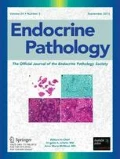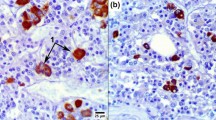Abstract
In mice transgenic for human growth hormone (GH) gene, pituitaries are significantly decreased in size and show morphologic changes in somatotrophs, lactotrophs, corticotrophs, and gonadotrophs that are due to the dual somatotropic and lactotropic effect exerted by the foreign hormone. To further elucidate the mechanisms by which GH, prolactin (PRL), and adrenocorticotropic hormone (ACTH) biosynthesis is regulated in this line of transgenic mice, we studied the pituitary content of GH, PRL, and proopiomelanocortin (POMC) mRNAs by in situ hybridization. Oligonucleotide probes labeled with35S were applied on paraffin sections of 7 pituitaries of transgenic mice (4 males and 3 females) and 7 pituitaries of sexmatched nontransgenic siblings. In both sexes, the number of cells and the intensity of hybridization signal for GH messenger RNA were decreased. In male mice, PRL mRNA was strongly diminished, whereas in female mice, no change was evident. The intensity of POMC mRNA signal was stronger in male transgenics than in the controls, The results suggest a decrease of GH gene transcription in both genders and of PRL gene only in males. In situ hybridization results are in accordance with previous immunocytochemical and ultrastructural findings describing inhibited somatotrophs in both sexes and suppressed lactotrophs in males.
Similar content being viewed by others
References
Bartke A, Steger AW, Hodges SL, Parkering TA, Colling TJ, Yun JS, Wagner TE. Infertility in transgenic female mice with human growth hormone expression: evidence for luteal failure. J Exp Zool 248:121–124, 1988.
Carrillo AJ, Sharp ZD, DePaolo LV. Correlation of rat pituitary prolactin messenger ribonucleic acid and hormone content with serum levels during the estrogen-induced surge. Endocrinology 121:1993–1999, 1987.
Cecim M, Ghosh PK, Esquifino AI, Began T, Wagner TE, Yun JS, Bartke A. Elevated corticosterone levels in transgenic mice expressing human or bovine growth hormone genes. Neuroendocrinology 53:313–316, 1991.
Chandrashekar V, Bartke A, Wagner TE. Endogenous human growth hormone (GH) modulates the effect of gonadotropinreleasing hormone in pituitary function and the gonadotroph response to the negative feedback effect of testosterone in adult male transgenic mice bearing human GH gene. Endocrinology 123:2717–2722, 1988.
Chandrashekar V, Bartke A, Wagner TE. Neuroendocrine function in adult female transgenic mice expressing the human growth hormone gene. Endocrinology 130:1802–1808, 1992.
Hammer RE, Brinster RL, Palmiter RD. Use of gene transfer to increase animal growth. Cold Spring Harbor Symp Quant Biol 50:379–387, 1985.
Hammer RE, Palmiter RD, Brinster RL. Partial correction of murine hereditary growth disorder by germ-line incorporation of a new gene. Nature 311:65–67, 1984.
Hartee AS, Kovacic N, Thomas M. Growthpromoting and lutcotrophic activities of human growth hormone. J Endocrinol 33:249–258, 1965.
Mathews LS, Hammer RE, Brinster RL, Palmiter RD. Expression of insulin-like growth factor I in transgenic mice with elevated levels of growth hormone is correlated with growth. Endocrinology 123:433–437, 1988.
Mayo KE, Hammer RE, Swanson LW, Brinster RL, Rosenfeld MG, Evans RM. Dramatic pituitary hyperplasia in transgenic mice expressing a human growth hormonereleasing factor gene. Mol Endocrinol 2: 606–612, 1988.
Melmed S, Ezrin C, Kovacs K, Goodman RS, Frohman LA. Acromegaly due to secretion of growth hormone by an ectopic pancreatic islet cell tumor. N Engl J Med 312:9–17, 1985.
Palmiter RD, Brinster RL, Hammer RE, Trumbauer ME, Rosenfeld MG, Brinberg NC, Evans RM. Dramatic growth of mice that develop from eggs microinjected with metallothionein-growth hormone fusion genes. Nature 300:611–615, 1982.
Palmiter RD, Norstedt G, Gelinas RE, Hammer RE, Brinster RL. Metallothionein-human GH fusion genes stimulate growth of mice. Science 222:809–814, 1983.
Penhoat A, Chatelain PG, Jaillard C, Saez JM. Characterization of somatomedin-C/ insulin-like growth factor I and insulin receptors on cultured bovine adrenal fasciculata cells. Role of these peptides on adrenal cell function. Endocrinology 122:2518–2526, 1988.
Posner BI. Characterization and modulation of growth hormone and prolactin binding in mouse liver. Endocrinology 98:645–654, 1976.
Sano T, Asa SL, Kovacs K. Growth hormone-releasing hormone-producing tumors: clinical, biochemical, and morphological manifestations. Endocr Rev 9:357–373, 1988.
Stefaneanu L, Kovacs K, Horvath E, Asa SL, Losinski NE, Billestrup N, Price J, Vale W. Adenohypophysial changes in mice transgenic for human growth hormonereleasing factor: a histological, immunocytochemical, and electron microscopic investigation. Endocrinology 125:2710–2718, 1989.
Stefaneanu L, Kovacs K, Horvath E, Losinski NE, Mayerhofer A, Wagner TE, Bartke A. An immunocytochemical and ultrastructural study of adenohypophyses of mice transgenic for human growth hormone. Endocrinology 126:608–615, 1990.
Stefaneanu L, Rindi G, Horvath E, Murphy D, Polak JM, Kovacs K. Morphology of adenohypophysial tumors in mice transgenic for vasopressin-SV40 hybrid oncogene. Endocrinology 130:1789–1795, 1992.
Steger RW, Bartke A, Parkening TA, Collins T, Buonomo FC, Tang K, Wagner TE, Yun JS. Effects of heterologous growth hormones on hypothalamic and pituitary function in transgenic mice. Neuroendocrinology 53:365–372, 1991.
Wagner TE, Hoppe PC, Jollick JD, Scholl DR, Hodinka RL, Gault JB. Microinjection of a rabbit β-globin gene into zygotes and its subsequent expression in adult mice and their offspring. Proc Natl Acad Sci USA 78:6376–6380, 1981.
Witorsh RJ, Kitay JL. Pituitary hormones affecting 5α-reductase activity: ACTH, growth hormone and prolactin. Endocrinology 91: 764–769, 1972.
Author information
Authors and Affiliations
Rights and permissions
About this article
Cite this article
Stefaneanu, L., Kovacs, K. & Bartke, A. In situ hybridization study of growth hormone, prolactin, and proopiomelanocortin mRNAs in adenohypophyses of mice transgenic for human growth hormone. Endocr Pathol 4, 73–78 (1993). https://doi.org/10.1007/BF02914455
Published:
Issue Date:
DOI: https://doi.org/10.1007/BF02914455




